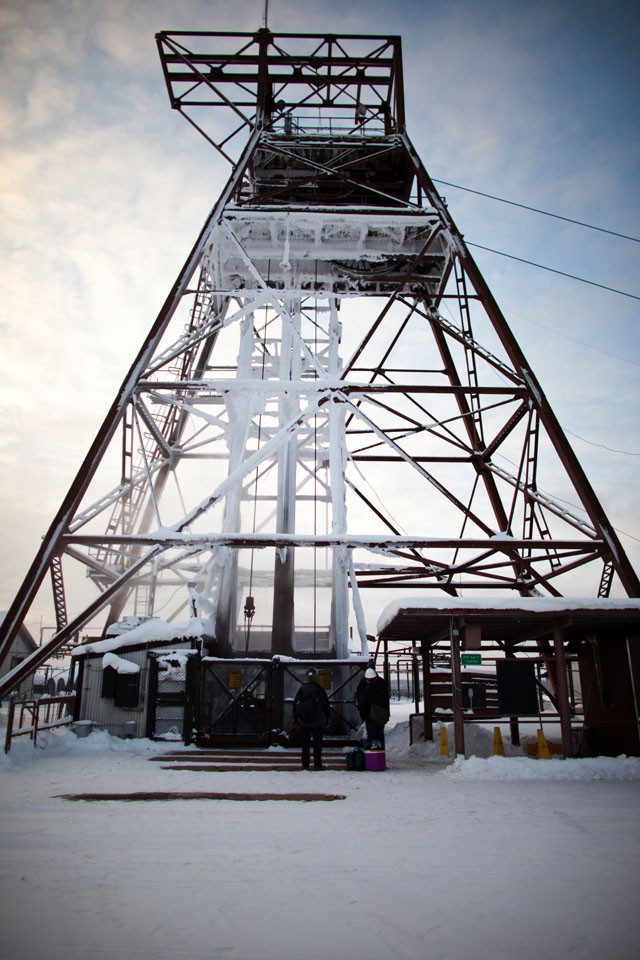Ears pop while descending a 110-year-old mine in an elevator the size of a small closet.
The pitch-dark ride to the âÄú27th floorâÄù (actually 689 feet below sea level) of the Soudan Mine lasts only three deafening minutes. Hard hats are required to ride in the rust-colored steel cage, but the unsettling voyage half a mile underground is the only way to get into MinnesotaâÄôs oldest and deepest mine.
Active mining has been nonexistent here since the 1960s, but that doesnâÄôt mean the once-booming iron mine, around which the town of Tower, Minn., was built, is empty.
Thousands of bats live in the mine 2,341 feet below the surface of MinnesotaâÄôs Vermilion Range, known for its vast deposits of iron. But the mine, only an hourâÄôs drive south of the Canadian border, isnâÄôt home to just bats.
Since the 1980s, scientists and graduate students from the University of Minnesota and other institutions have visited Tower, population of 502, to use the depth and location of the mine to conduct experiments away from the surface, where cosmic rays bombard the earth.
These experiments are being carried out with the hope of one day answering questions about the 96 percent of the universe that is largely unknown.
âÄúYou would think we would know more about our own universe,âÄù said Alec Habig, associate director of the lab. âÄúBut sadly, we donâÄôt.âÄù
The original mining tunnels are too narrow and dangerous to host any physics experiments, but two large excavations that removed more than 100,000 tons of Ely Greenstone, a rock that dates back 2.7 billion years, have allowed the Soudan Underground Laboratory to host a series of experiments with the goal of understanding the structure of the universe.
One of fewer than a dozen such labs in the world, the laboratory is hidden in MinnesotaâÄôs vast wilderness and natural beauty and is home to two major experiments, Main Injector Neutrino Oscillation Search and Cryogenic Dark Matter Search II.
The latter, currently under calibration in preparation for data collecting scheduled to start before spring, is the last planned major experiment at the lab before its lease with the Department of Natural Resources expires.
Waiting on WIMPs
Fewer than a dozen scientists, researchers and engineers work 10-hour days underground, looking for dark matter âÄî an unknown material in the universe.
âÄúThereâÄôs this whole theory that dark matter exists,âÄù said Jim Beaty, an engineer at the lab who works on the CDMS II experiment.
âÄúThe first indication is by the way the planets move in the universe,âÄù said Beaty, who said stars are seemingly moving apart at the same speed, implying expansion.
Some type of particle that doesnâÄôt emit or absorb light must be providing âÄúgravitational glueâÄù that keeps the galaxies uniform, Beaty said.
The CDMS II experiment, using a germanium crystal, is stored in a contraption similar to a Russian nesting doll where each layer is significantly cooler to the point of only a tenth of a degree above absolute zero.
At this temperature, molecular motion is at a minimum, and when a weakly interacting massive particle (WIMP) hits the nucleus of the crystal, the crystal will âÄúshake.âÄù
âÄúIf you want to see a stone thrown into a lake, if the windâÄôs blowing, youâÄôre not going to see the stone hit the lake,âÄù Beaty said. âÄúIf the lake is perfectly calm, youâÄôre going to see the ripple from the stone.âÄù
Beaty and others look for the crystal to shake, but additional particles can also trip the sensor and cause a similar disturbance. In order to determine if it was a WIMP interaction, scientists look for a signature ratio of charge-to-heat in order to identify what set off the sensor.
A WIMP interacting with a particle is very rare, Beaty said, but observing the interaction could lead to proof of dark matterâÄôs existence.
Ten trillion WIMPs, which appear to be related to photons, pass through a kilogram of solid material on Earth every second, but as few as one a year will interact with an atom.
âÄúItâÄôs a waiting game,âÄù Habig said.
In early 2010, the labâÄôs first CDMS experiment results showed two potential interactions of WIMPs over a four-year period.
Those, however, are not enough to indicate that dark matter has actually been discovered, said University physics Professor Priscilla Cushman, who has worked with the CDMS.
âÄúTwo [possible detections] are not enough to say that dark matter has been found,âÄù explained Habig, who said that if there had been any more than two, there would be more basis to believe dark matter had been found.
Deciphering neutrinos
457 miles away in Chicago, the U.S. Department of EnergyâÄôs Fermilab constantly fires a beam of man-made neutrinos at the Soudan Lab where the Main Injector Neutrino Oscillation Search (MINOS), is being conducted.
Neutrinos are naturally created by cosmic rays from the sun and do not affect humans, but understanding them would be significant to understanding the most common massive particle in the universe.
The beam of neutrinos from Fermilab shot at a detector in Soudan, located in a 270-foot-long room with a ceiling 40 feet high.
Built using 486 octagonal steel plates, each an inch thick and weighing a total of 6,000 tons, the steel plates are sitting ducks to the constant stream of neutrinos that travel at the speed of light.
Every so often, a neutrino will make direct contact with the steel plate, resulting in a spray of ordinary particles.
Researchers like Habig can use the data from the resulting spray to better understand neutrinos.
âÄúIt is similar to playing a game of pool where the cue ball is invisible and you can only see the resulting collision,âÄù Habig said. âÄúBy watching how the balls break, you can determine where the shot came from.âÄù
Future of Soudan
Physics Professor Marvin Marshak and his wife first visited the Soudan Mine as tourists. Shortly after, Marshak was looking for an underground mine to be retrofitted for a laboratory dealing with the decay of protons.
âÄúWhen we were looking for a site [for the lab], my wife sort of got mad at me because we were looking at mines in Colorado and California,âÄù Marshak said. After being reminded by his wife of the Soudan mine, Marshak decided to launch the lab closer to home.
The two major experiments at Soudan are living their last days as MINOS and will potentially be shut down this year, Cushman said.
CDMS II, will likely wrap up in one or two years and will potentially be moved to a laboratory two miles underground in Canada, Marshak said.
MINOS will have to be removed from the mine, however, which will take two to three years.
Whether the lease will be renewed is up in the air, Marshak said, and depends on if the lab picks up any more major projects.
âÄúWe have this wonderful facility underground,âÄù said Cushman, who admitted that the future is uncertain. âÄúBut when these experiments end at Soudan, the big question is whether the University is going to maintain this valuable underground real estate or not.âÄù
Daily Email Edition
Get MN Daily NEWS delivered to your inbox Monday through Friday!

Published April 18, 2024

Published April 18, 2024

Published April 18, 2024
Trending
Scanning for universe’s dark matter, 2,341 feet deep
The Soudan Mine lab in northern Minnesota is an epicenter of dark matter research.

Image by Anthony Kwan
he headframe stands above the Soudan Underground Laboratory at the Soudan Underground Mine State Park. Physicists use the “Cage” to travel half a mile down to the underground research laboratory.
by Frank
Published January 24, 2011
Leave a Comment
More to Discover
Advertisement
The Minnesota Daily • © 2024 The Minnesota Daily • Privacy Policy • FLEX Pro WordPress Theme by SNO • Log in













